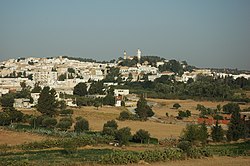
Back زغوان Arabic زغوان AZB Zaghouan Catalan Zaghouan (kapital sa lalawigan sa Tunisia) CEB Zaghouan CY Zaghouan German Ζαγκουάν Greek Zaghouan Spanish زغوان FA Zaghouan French
This article includes a list of general references, but it lacks sufficient corresponding inline citations. (December 2019) |
Zaghouan
زغوان ⵣⴻⵖⵡⴰⵏ | |
|---|---|
 Zaghouan Governorate | |
| Coordinates: 36°24′20″N 10°08′35″E / 36.40556°N 10.14306°E | |
| Country | |
| Governorate | Zaghouan Governorate |
| Delegation(s) | Zaghouan |
| Government | |
| • Mayor | Tarek Zoughari (Independent) |
| Population (2022) | |
• Total | 22,637 |
| Time zone | UTC+1 (CET) |
Zaghouan (or Zaghwan; Arabic: زغوان ⓘ; Berber languages: ⵣⴻⵖⵡⴰⵏ / Zeɣwan) is a town in the northern half of Tunisia.
Situated on a low ridge of the Dorsale Mountains, the town has a mild climate and presents a green aspect. Cold water from here was taken by the Zaghouan Aqueduct to Carthage. The town is famous for its roses, originally cultivated by Muslim refugees from Spain in the seventeenth century. The town is located around 60 km due south of Tunis and around 50 km inland (west) from the Gulf of Hammamet and has an estimated population of around 20,837 (2014). It is the capital of the Zaghouan Governorate.
On the mountain south of the city is the Roman Water Temple Djebel Zaghouan (Temple de Eaux), source of an aqueduct which used to take water to the city of Carthage over 100 km away. The ruins here are illustrated in Fisher's Drawing Room Scrap Book, 1840, as 'Temple and Fountain of Zagwhan', the painting being by Sir Greenville Temple with a poetical illustration by Letitia Elizabeth Landon.[1]
- ^ Landon, Letitia Elizabeth (1840). "picture". Fisher's Drawing Room Scrap Book, 1841. Fisher, Son & Co. Landon, Letitia Elizabeth (1840). "poetical illustration". Fisher's Drawing Room Scrap Book, 1841. Fisher, Son & Co.
